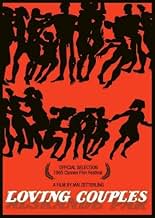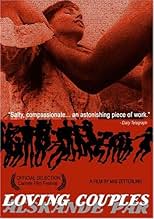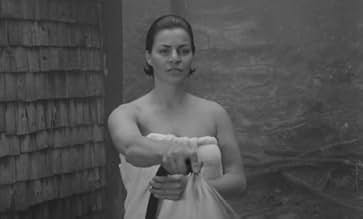1914, Stockholm. Trois femmes sur le point d'accoucher se rendent à l'hôpital. De conditions sociales diverses, Agda, Adele et Angela se remémorent leur enfance, leurs amours déçus et leurs ... Tout lire1914, Stockholm. Trois femmes sur le point d'accoucher se rendent à l'hôpital. De conditions sociales diverses, Agda, Adele et Angela se remémorent leur enfance, leurs amours déçus et leurs illusions perdues..1914, Stockholm. Trois femmes sur le point d'accoucher se rendent à l'hôpital. De conditions sociales diverses, Agda, Adele et Angela se remémorent leur enfance, leurs amours déçus et leurs illusions perdues..
- Réalisation
- Scénario
- Casting principal
- Récompenses
- 1 nomination au total
Jan-Erik Lindqvist
- Peter von Pahlen
- (as Jan-Eric Lindquist)
Avis à la une
Technically speaking, this is a good film--with decent cinematography and production values. But, while it is a competent film, I also found myself wanting to turn off the DVD repeatedly because I just didn't find myself at all interested. There are a variety of reasons, though the biggest of which is because it seemed as if I'd seen all this before in various Ingmar Bergman movies--in particular, THE BRINK OF LIFE ("Nära livet"--1958). Also , the angst and sense of isolation and fruitlessness of life was pervasive and just made me feel depressed. After watching this film, I could easily say that the overall message of the film is "life stinks and love is a sham,...then you die".
Now this does NOT mean that I think all movies must be upbeat or positive in tone--far from it. But even a grim movie can be great and compelling when you feel SOME connection to the characters. For example, I just recently saw De Sica's THE CHILDREN ARE WATCHING. It is a major tear-jerker and is the extremely sad story about the break up of a marriage and its impact on a child. BUT, I really cared about De Sica's characters and cared absolutely nothing for Zetterling's. Of the three women featured in the film, one was a lady of privilege with little depth or personality, one a bubble-headed servant and the other a bitter and nasty soul. I just wanted them all to go away and leave me alone!
Now as for this being a controversial film--which it definitely was when it debuted in the 1960s. The nudity but especially the themes of homosexuality and lesbianism were pretty controversial for its day, though by today's standards it's all pretty tame. I still wouldn't let my kids watch the film, but not just because of the nudity and themes but because I love my kids too much to make them watch such an unappealing film.
Now this does NOT mean that I think all movies must be upbeat or positive in tone--far from it. But even a grim movie can be great and compelling when you feel SOME connection to the characters. For example, I just recently saw De Sica's THE CHILDREN ARE WATCHING. It is a major tear-jerker and is the extremely sad story about the break up of a marriage and its impact on a child. BUT, I really cared about De Sica's characters and cared absolutely nothing for Zetterling's. Of the three women featured in the film, one was a lady of privilege with little depth or personality, one a bubble-headed servant and the other a bitter and nasty soul. I just wanted them all to go away and leave me alone!
Now as for this being a controversial film--which it definitely was when it debuted in the 1960s. The nudity but especially the themes of homosexuality and lesbianism were pretty controversial for its day, though by today's standards it's all pretty tame. I still wouldn't let my kids watch the film, but not just because of the nudity and themes but because I love my kids too much to make them watch such an unappealing film.
Both in the ambiance and in its women's themes in this movie you can see unequivocally Bergman's influences. In particular It recalls Bergman's SECRETS OF WOMEN (1952)for the cast ( It's almost the same!)and for its episodic structure. The psychological search on women universe is another important link.
Anyway, although Mai Zetterling had abused it in her movies, I think that the flashback use is very interesting in this movie. It becomes, with the editing help, a concrete tragic matter and not only a way to tell the story. I give it a 6.
Anyway, although Mai Zetterling had abused it in her movies, I think that the flashback use is very interesting in this movie. It becomes, with the editing help, a concrete tragic matter and not only a way to tell the story. I give it a 6.
The story of three women from different, but related, backgrounds about to give birth in a hospital in Sweden around the start of World War I.
Via inter-cut flashbacks we are shown how they ended up in their situation.
Often beautiful Sven Nykvist photo and many great directorial flourishes from director Mai Zetterling makes this a treat.
The parallels with Bergman are many. For instance, apart from Mr. Nykvist, many of the actors have appeared in various Bergman productions, the themes dealt with here are very similar to various Bergman films, and so on. Dissimilar enough to be interesting though.
Has some very interesting scenes that I would imagine were very controversial at the time, such as two gay men frolicking and getting mock-married in a church, a graphic shot of a baby's birth, some female nudity, a lesbian kiss, etc..
Via inter-cut flashbacks we are shown how they ended up in their situation.
Often beautiful Sven Nykvist photo and many great directorial flourishes from director Mai Zetterling makes this a treat.
The parallels with Bergman are many. For instance, apart from Mr. Nykvist, many of the actors have appeared in various Bergman productions, the themes dealt with here are very similar to various Bergman films, and so on. Dissimilar enough to be interesting though.
Has some very interesting scenes that I would imagine were very controversial at the time, such as two gay men frolicking and getting mock-married in a church, a graphic shot of a baby's birth, some female nudity, a lesbian kiss, etc..
It's a wonderful film although certainly a rather cynical view of marriage and love, evidently in Sweden in 1914, or maybe somewhere else and a later time. The ladies, Alda, Adela and Angela played by Harriet Anderson, Gunnel Lindalom and Gio Petre absolutely splendidly. At the beginning there are the three in the stark hospital and all each expecting a child. There are three rather different stories and we have flashbacks of them so the slow and rather sad beginning really gets going with a lot of fun and sex and surprises all the time. There is nudity and passionate scenes that it is rather surprising for the early 60s and caused a problem in many countries. The cinematography is fantastic by Sven Nykvist like the shots in the woods and with the frolicking and much drinking during the midsummer celebration and also in the fantastic pretend marriage with two gays and the sublime Anderson.
There is no doubt that the Swedish actress Mai Zetterling, in her feature-length directing debut, had Ingmar Bergman in her mind: the cast is full of Bergman veterans, the cinematography is by the emblematic Bergman collaborator Sven Nykvist, and the whole style of the movie is modelled on her famous compatriot. Technically, the imitation is accurate: the film is well-made, the acting is fine, and I liked how Zetterling contrasted three different types of women - one happy all the time, one never happy, one somewhere in between. But the stories are too long and meandering, and for a movie so heavily dependent on flashbacks (about 80% of the running time), the flashbacks themselves are not especially revealing. **1/2 out of 4.
Le saviez-vous
- AnecdotesMai Zetterling's directorial debut.
- Citations
Dr. Jacob Lewin: I can't do much unless you take your pants off and lie down.
- ConnexionsFeatured in Vielleicht bin ich wirklich eine Zauberin (1989)
- Bandes originalesBagni di Lucca
Composed by Giuseppe Manente (1903)
Meilleurs choix
Connectez-vous pour évaluer et suivre la liste de favoris afin de recevoir des recommandations personnalisées
- How long is Loving Couples?Alimenté par Alexa
Détails
- Durée1 heure 58 minutes
- Couleur
- Mixage
- Rapport de forme
- 1.66 : 1
Contribuer à cette page
Suggérer une modification ou ajouter du contenu manquant

Lacune principale
By what name was Les amoureux (1964) officially released in India in English?
Répondre




































